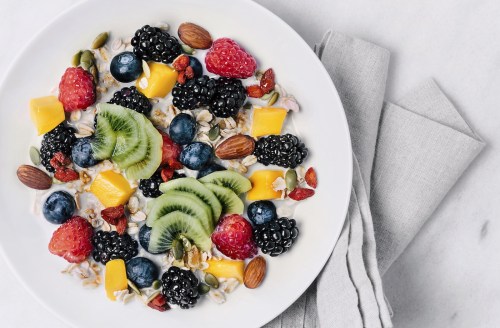If you had to describe my ideal food plan in two words, it would be: always eating. I am an all-day grazer; a person who excitedly thinks about her upcoming dinner while eating breakfast. Which is why one of the biggest trends in the wellness world, intermittent fasting, is hard for me to wrap my mind around. Lucky for me—and anyone else confused about the popular eating style—Tracy Lockwood Beckerman, RD, breaks down its pros and cons in the latest episode of You Versus Food,Well+Good’s YouTube series dedicated to answering your biggest questions about nutrition.
For the uninitiated: “Intermittent fasting is a diet in which people fast for a specific period of time at some point in their schedule,” says Beckerman. Generally, the focus of IF is less on what you eat, she says, and more on when you’re eating.
However, the term “intermittent fasting” doesn’t refer to one specific type of eating plan—there are actually several different iterations of intermittent fasting that people practice, Beckerman says. And they range from the somewhat restrictive to the extreme. Here’s your cheat sheet:
1. The 16:8 method: This is the most common type of intermittent fasting—and generally, the easiest to follow. Basically, it means that in a given day, a person eats during an eight-hour window and fasts the rest of the time.
2. The 5:2 method: You fast for two days of the week on this plan, says Beckerman. But it’s not a total fast: On the fasting days, you limit your calorie intake to 500 to 600 per day. The other five days of the week, you eat normally.
3. The “Eat-Stop-Eat” method: This one is similar to 5:2, except a person doesn’t eat at all for a 24-hour period once or twice during the week. “During the fast, you are allowed water, coffee, and non-caloric beverages—but no solid food,” says Beckerman.
4. Alternate-day fasting: This is one of the more restrictive interpretations of intermittent fasting. People on this plan fast every other day, eating 500 calories on their fasting days. “This is thought to be very extreme,” says Beckerman. “Not for beginners—it’s not recommended for many people.”
5. The Warrior Diet: “You fast during the day and eat a big meal at night,” Beckerman says. People can eat raw fruits and vegetables during the day, and the rest of your day’s nutrition comes in a four-hour window in the evening. Unlike other forms of IF, this plan does care about what foods you eat. “It emphasizes choices similar to the Paleo diet,” Beckerman adds. (So: no processed foods and lots of fresh produce.)
While Silicon Valley types might make the more restrictive versions of IF look cool (*cough* Twitter CEO Jack Dorsey *cough*), Beckerman stresses that intermittent fasting (and its many different varieties) is not for everyone. “Restricting your food intake this way can easily lead to disordered eating in some people,” she says. Which is why, she stresses: “First and foremost, work with a doctor or registered dietitian if you’re interested in this diet. A professional should be your number one resource here. Not Google, not even this video! Everyone is different and pros can help you with an individualized plan.”
Curious about other buzzy eating plans? Here’s what you should know about the Okinawa diet and the ketogenic diet.
Sign Up for Our Daily Newsletter
Get all the latest in wellness, trends, food, fitness, beauty, and more delivered right to your inbox.
Got it, you've been added to our email list.











